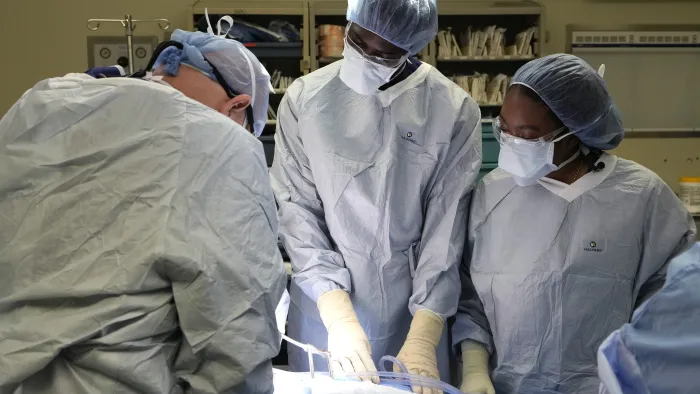By Lauren Neergaard
It’s long after midnight when the bustling operating room suddenly falls quiet — a moment of silence to honor the man lying on the table.
This is no ordinary surgery. Detrick Witherspoon died before ever being wheeled in, and now two wide-eyed medical students are about to get a hands-on introduction to organ donation.
They’re part of a novel program to encourage more Black and other minority doctors-to-be to get involved in the transplant field, increasing the trust of patients of color.
“There are very few transplant surgeons who look like me,” said Dr. James Hildreth, president of Meharry Medical College, which teamed with Tennessee Donor Services for the project — one of several by historically Black colleges and universities to tackle transplant inequity.
Fresh off their first year at Meharry, six students spent the summer shadowing the donor agency to learn the complex steps that make transplants possible: finding eligible donors, broaching donation with grieving families, recovering organs and matching them to recipients sometimes hundreds of miles away.
In the operating room, student Teresa Belledent worried she’d get emotional seeing a donor’s face — especially this one, a Black father of six, just 44, who reminded her a bit of her own dad. Instead, calm descended as Dr. Marty Sellers, the organ agency’s surgeon, began retrieving the kidneys and liver while teaching Belledent and classmate Emmanuel Kotey.
“I’m able to feel sad and honor this person … and be able to focus on the act of helping other people,” said Belledent as the tired team began the two-hour drive back to Nashville from the Jackson, Tennessee, hospital. The night’s tougher lesson: Hours into the surgery the room falls quiet again. The donor had died of a brain hemorrhage but now Sellers has found undiagnosed cancer in his lungs. The kidneys and liver, already carefully placed on ice, can’t be used. Still, the corneas can be donated — and for the two students, the surgery offered a powerful teaching moment.
“I got to see so much and do so much — and trying is better than not,” Belledent said.
MISTRUST AND THE TRANSPLANT GAP
Despite record numbers of transplants in recent years, thousands die waiting because there aren’t enough donated organs — and some don’t get a fair chance. Black Americans are over three times more likely than white people to experience kidney failure. But they face delays in even being put on the transplant list and are far less likely than their white counterparts to get an organ from a living donor — the best kind.
Overall, Black patients make up 28% of the waiting list for all organs but account for just about 16% of deceased donors. Increasing donor diversity also helps improve the odds of finding a good match.
“How do we close that gap?” was the question Jill Grandas, Tennessee Donor Services’ executive director, took to Hildreth.
The Meharry students know mistrust of the medical system — a legacy of abuses such as the infamous Tuskegee experiment that left Black men untreated for syphilis — is a barrier both to organ donation and seeking care, such as transplants, that people may not be familiar with.
Austin Brown of Memphis said his grandfather “absolutely despised medicine,” and died of a heart attack after refusing an artery-clearing stent.
Belledent, of Miami, recalled her mother saying not to check the organ donor box when she got her driver’s license — because of a widespread myth that doctors won’t work as hard to save the life of a registered donor.
“Now that I’ve seen the process, it’s crazy to even think about,” Belledent said. “In the ICU, no one’s looking through stuff and trying to find your license, look for the (organ donor) heart on there.”
Stacey Scotton of Cleveland, Tennessee, said a cook in Meharry’s cafeteria listed the reasons he’s heard “that it’s not a good idea to be an organ donor. And I’m able to now go in and comfort him and correct, you know, some of those disbeliefs.”
AWE IN THE OPERATING ROOM
Back at the Jackson, Tennessee, hospital, Kotey and Belledent are getting a very different anatomy lesson than medical students’ introductory lab with cadavers.


